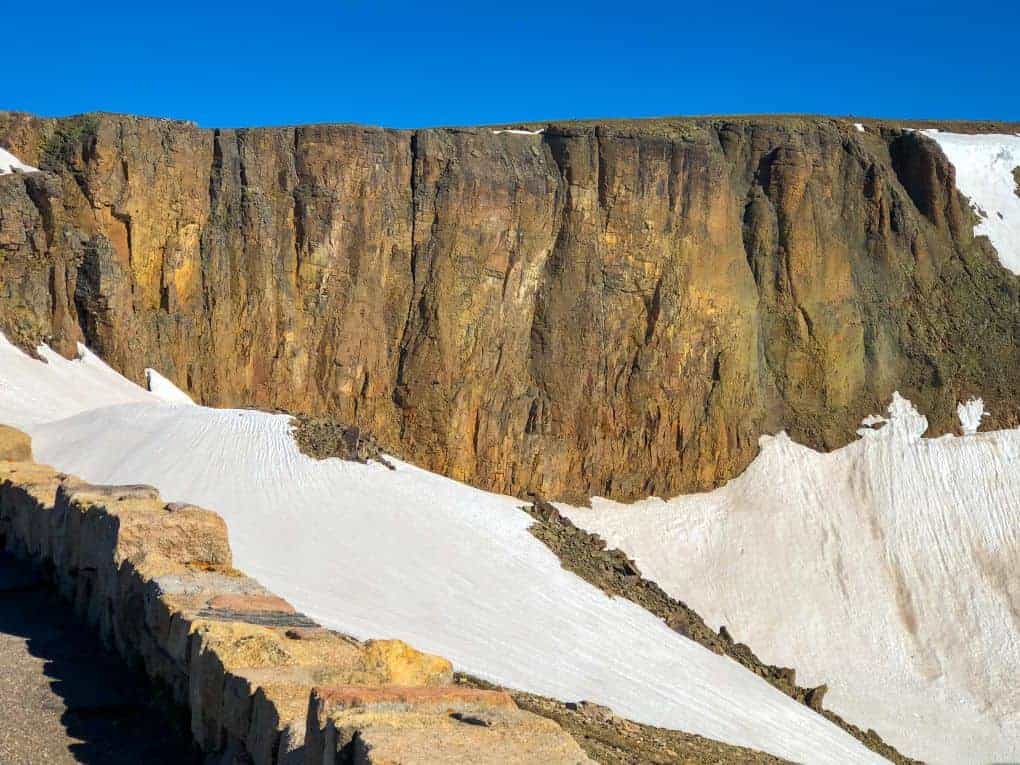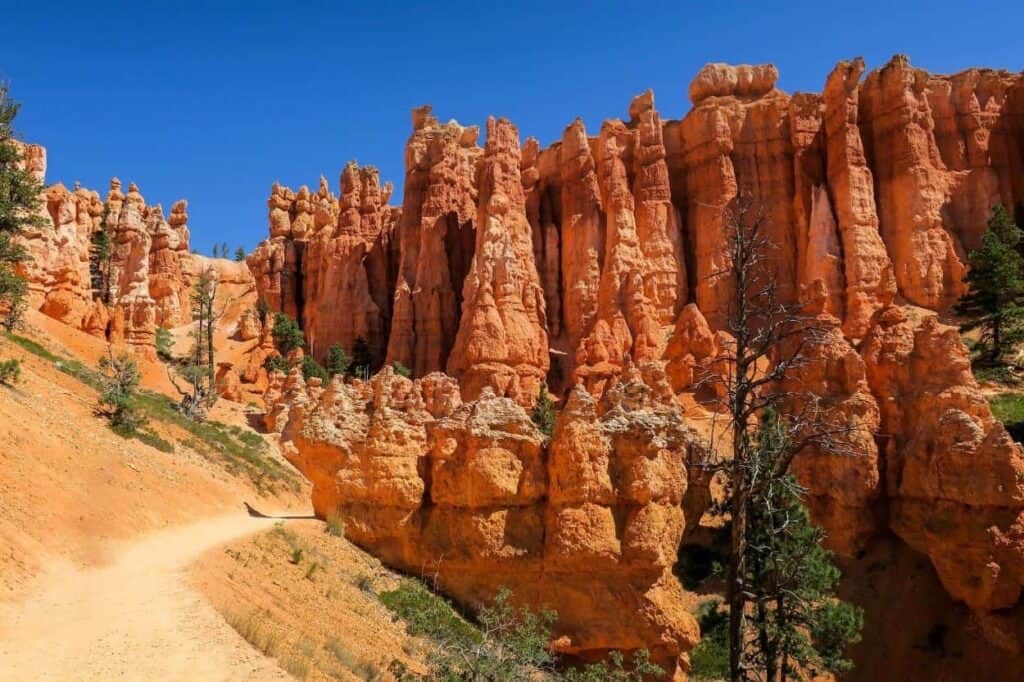Table of Contents
Updated April 2024
Have you ever dreamed of embarking on an epic journey through the heart of the American Southwest? A Southwest Grand Circle Road Trip Itinerary is the ultimate adventure for travelers eager to explore vast desert landscapes, iconic red rock formations, and world-renowned national parks. Whether you’re aiming to complete the famous Utah Mighty 5—Arches, Canyonlands, Capitol Reef, Bryce Canyon, and Zion—or hoping to add in unforgettable stops like Monument Valley and Antelope Canyon, careful planning is key. This guide will help you craft a route that maximizes your time, covers the top sights, and ensures you don’t miss a moment of the breathtaking scenery this legendary loop has to offer.
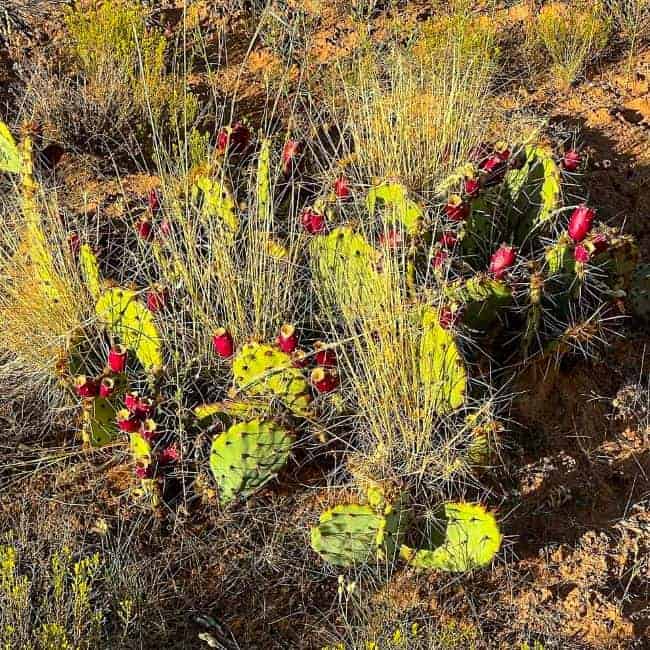
Discovering Iconic National Parks and Monument Sites on Your Grand Circle of the Southwest

This post may contain affiliate links, meaning if you purchase something through one of these links, we may earn a small commission at no extra cost to you! Read the full disclosure policy here
PRO Tip: This itinerary can be customized based on personal preferences, availability of accommodation, and seasonal park closures. It’s also important to note that the distances between parks can be quite significant, so be prepared for long drives.
Southwest Grand Circle Road Trip Itinerary-Day 1
Day 1: Las Vegas to Zion National Park
- Drive from Las Vegas to Zion National Park (approximately 3 hours)
- Spend the day exploring the park, hiking the trails, and taking in the breath-taking scenery.
- Stay overnight in or near the park.
If you are flying and renting a vehicle, you could start and end in Las Vegas, or Salt Lake City, Utah or Phoenix, Arizona, which are major flight destinations. Either destination will get you started. If you get an early flight, you can start with a side trip to Red Rocks Canyon on your way to Zion National Park.

A Side Trip to Rocks Canyon National Conservation Area
Situated just 15 miles west of Las Vegas, Nevada, the Red Rock Canyon Conservation Area spans over 195,819 acres within the Mojave Desert. This protected landscape features a diverse array of natural wonders, including towering red sandstone cliffs, rugged canyons, and vast desert vistas.
NOTE: *Timed Reservations are required for vehicle entry to the Scenic Loop between 8am-5pm from October 1 through May 31. Timed reservations are available online, along with daily entry passes, and visitors with an annual or lifetime pass. Make your reservation here: Red Rock Reservations for Timed Entry.

Your Guide to Red Rock Canyon: Exploring Nature’s Wonderland
Rock Canyon is located 15 miles west of the Las Vegas-Carrion Airport on
- State Route 159. Take I-15 north.
- At Exit 42A, merge onto US-95 north
- Take exit 81A toward Summerlin Parkway
- Take exit 26 for Charleston Boulevard/State Route 159
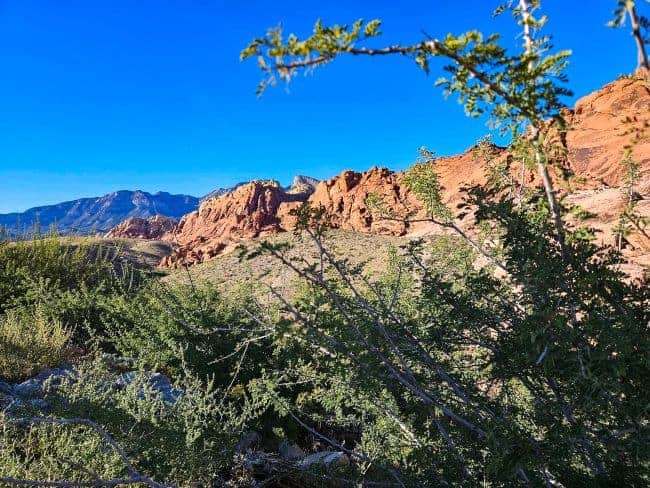
What Things Can I Do at Red Rocks National Conservation Area?
Hiking trails are the best way to explore the natural wonders. If you are looking for an easy hike, try the Lost Creek Trail. This is a fairly flat trail that will take you to a splendid grotto with a waterfall. Visit in the morning or late afternoon for fewer people and cooler weather.
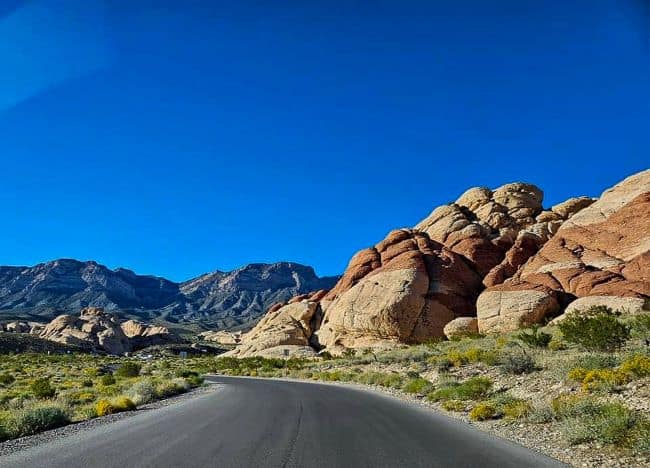
Visitors to Red Rock Canyon will get a real Southwest experience. The terrain on the scenic drive is pretty impressive. Besides the scenic drive, you can enjoy hiking, rock climbing or maybe attend a ranger-led program. This park is a favorite with locals living in Las Vegas, so venture out early.
Our first stop in a park is always the visitor center. Here, we can pick up maps and get important park updates at the information desk. Park rangers are always willing to share trail information, valuable wildlife sightings, and other interesting tidbits. Since we were short on time, we took the scenic one-way loop drive.
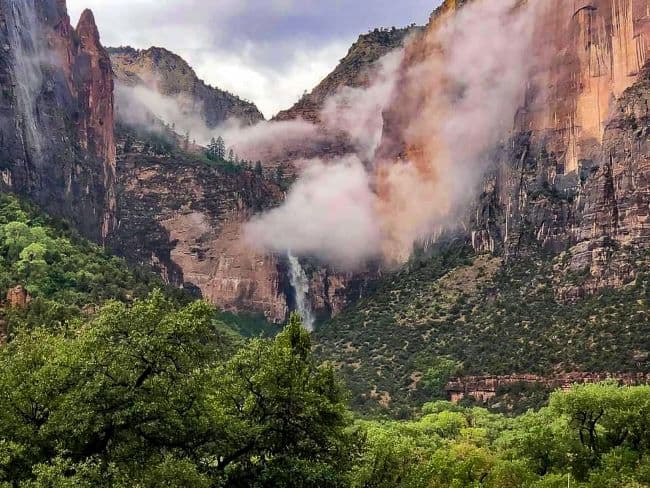
From Neon Lights to Natural Wonders: Driving from Las Vegas to Zion National Park
For a more scenic drive that takes you through some of the stunning landscapes of southern Utah, consider taking Utah State Route 14 east from Interstate 15. This road winds through the mountains and canyons of the Dixie National Forest and past the striking red rock formations of Cedar Breaks National Monument. From there, connect with US Route 89 south and then Utah State Route 9 west into Zion National Park. This route takes approximately 3 to 4 hours, depending on traffic and road conditions. Road trips are as much about the journey as the destination. Take time to enjoy the drive, discovering the many hidden gems along the way. For us, this creates memories that last a lifetime.
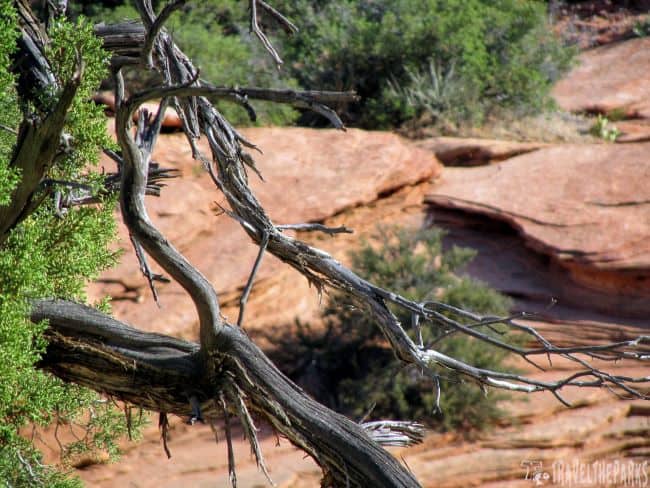
Exploring the Majesty of the Southwest: A Grand Circle Road Trip Itinerary in Zion National Park
In this park, Zion National Park, there are an abundance of activities for all skill levels. I would seriously consider dedicating a minimum of two days to explore and truly appreciate all Zion has to offer. For us, Zion National Park was our priority bucket list destination of all the mighty Utah 5 parks.
Zion National Park boasts an array of renowned hiking trails, such as The Narrows, a slot canyon trek requiring wading through water; Angels Landing, a vertiginous, narrow path with a 1,500-foot precipice; and Observation Point, which rewards hikers on the East Mesa Trail with a breathtaking aerial vista of Zion Canyon.
Pro Tip: As of April 1, 2022, a permit is required to hike Angels Landing in Zion National Park. Be sure to enter the lottery in advance at Recreation.gov

Zion National Park Accommodation Guide: Where to Stay and Experience Nature’s Splendor
You can stay at the Zion Lodge in the park or find a hotel in nearby Springdale. If you prefer camping, the park has two campgrounds: Watchman Campground is open year-round, and the Lava Point Campground off Kolob Terrace Road is seasonal. Reservations need to be made 6-month before your trip at recreation.gov. Springdale also has great lodging for both summer and winter.
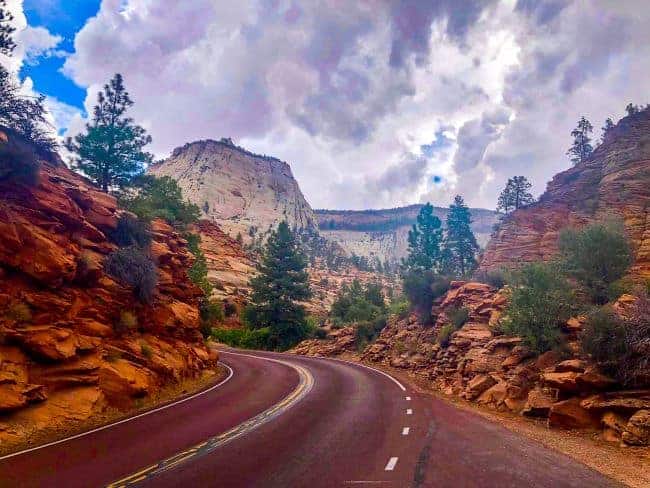
What Things Can I Do in Zion National Park
On your first day in the park, I would attempt the memorable Narrows hike at the end of the Temple at Shinawava (Riverwalk Trail). My advice would be to get an early start. This is an advantage of staying in the park. You can go as far as you like depending on your hiking fitness and, of course, have ample time. Most visitors will tackle the Angels Landing trail. I prefer the Narrows. Consider other hikes that are not as crowded.
- Canyon Overlook Trail – easy 1-mile RT near the Mt. Carmel Tunnel. A little intimidating if you have a fear of heights. This is a great hike to watch the sunrise.
- Shelf Canyon Trail – easy 0.7-mile out & back trail. It requires just a bit of scrambling around boulders to reach the slot canyon. Take your time and enjoy it.
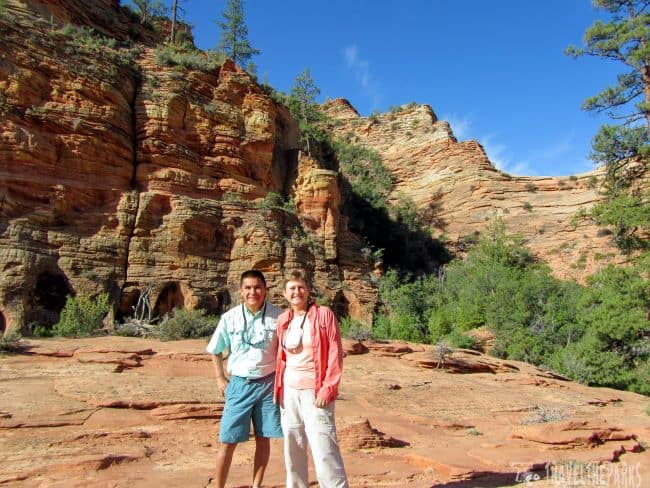
If hiking is not your cup of tea, take time to check out one of the visitor centers. There are three of them. Each has unique exhibits that detail the area’s history, culture, and geological information. The Natural History Museum has interesting displays and, best of all, it is free! Take part in a Ranger-led talk or drive to the Zion-Mt. Carmel Scenic Highway, stopping at Checkerboard Mesa. Zion is sure to leave a lasting impression no matter what you do. The sheer red rock cliffs, jagged peaks and the low Virgin River valley are incredible.
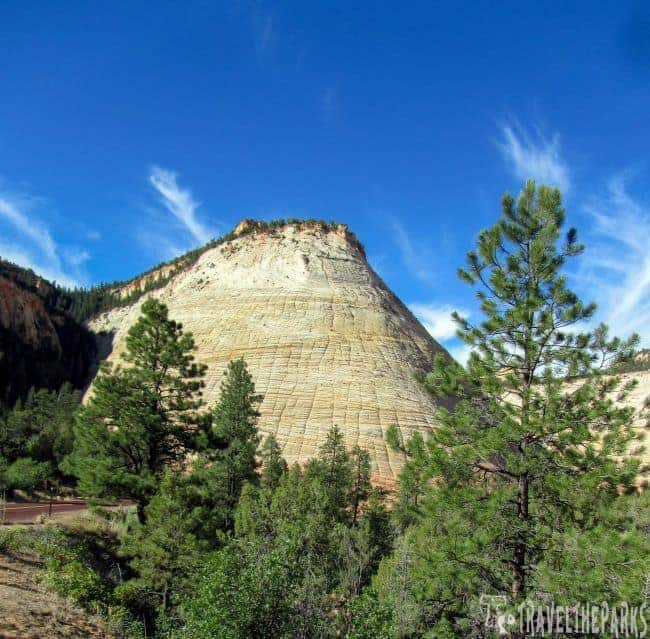
Southwest Grand Circle Road Trip Itinerary-Day 2
- Drive from Zion National Park to Bryce Canyon National Park (approximately 2.5 hours)
- Spend the day exploring the park, hiking the trails, and marveling at the unique rock formations.
- Stay overnight in or near the park.
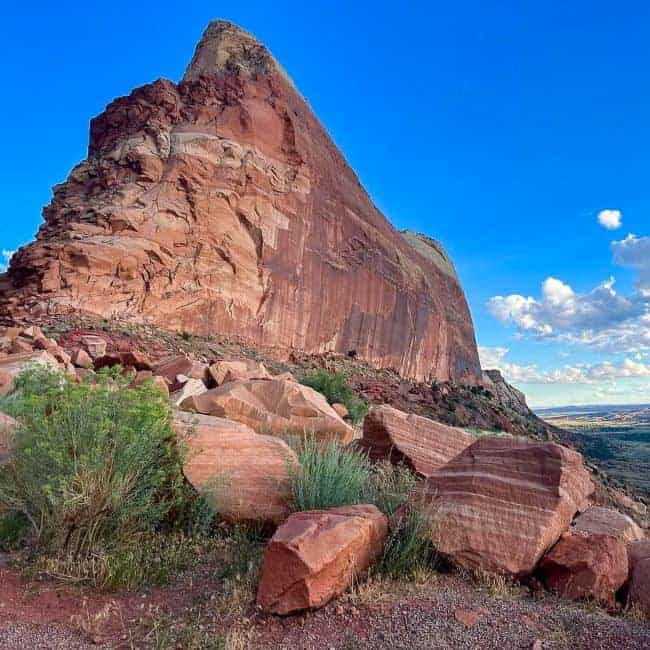
Driving from Zion to Bryce: A Scenic Journey through a Southwestern Mozaic
- Take Route 9 east from Zion National Park, passing through the charming town of Springdale and the stunning red rock scenery of the Zion-Mt. Carmel Highway.
- Continue on Route 9 through the breathtaking scenery of the Zion Canyon and the Checkerboard Mesa formation.
- Take Route 89 north to Bryce Canyon National Park
- Along the way, you can stop at the Red Canyon Visitor Center and take a short hike to see the unique rock formations, arches, and hoodoos.
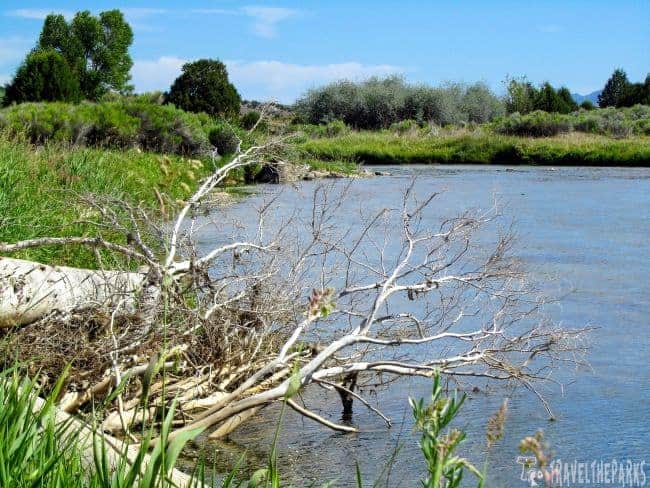
The long valley parallels the East Fork of the Virgin River, dotted with many small historical Mormon towns where pioneers established farms and ranches across the Colorado Plateau. Near Hatch, the Sevier River winds through the valley, meandering past large cattle-grazed pastures. This river supports three different trout species, which the local fish hatchery periodically restocks. For those interested in fly-fishing, the Sevier River provides an excellent angling opportunity.
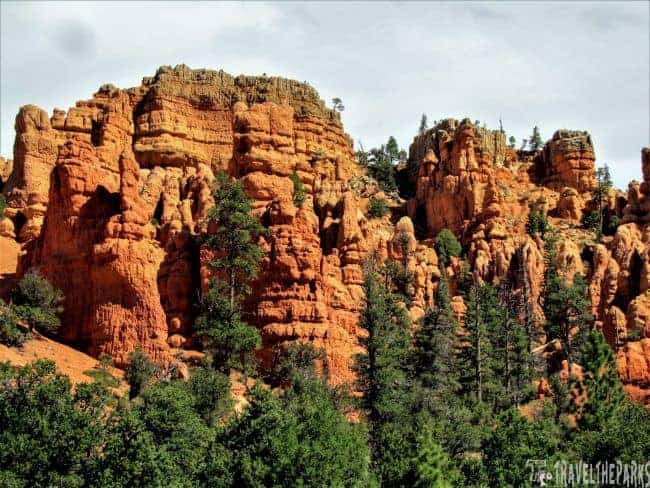
Red Canyon in Dixie National Forest – A Must-Stop on Your Southwest Road Trip
Approximately 7 miles east of Panguitch, Utah, on Highway 89, turn onto Highway 12. Before reaching Bryce Canyon, UT-12 passes through two striking red rock tunnels in Red Canyon, part of the Dixie National Forest. Though often overshadowed by the famous Bryce Canyon, this area is known for its vibrant red rock formations and unique geological features like hoodoos and spires that differ greatly from Zion or Bryce. The visitor center can provide trail information for those who take the time to explore this remarkable landscape by mountain bike or on foot. While many travelers speed past with only a glance, the area’s dramatic red sandstone pinnacles and formations are definitely worth a closer look.
Red Canyon is part of the Dixie National Forest, spanning over 2 million acres in southern Utah. The forest area is renowned for its many recreational opportunities. Outdoor enthusiasts flock here for the hiking, camping, fishing, and hunting. Not to mention the diverse range of wildlife, including elk, mule deer, black bears, and mountain lions.
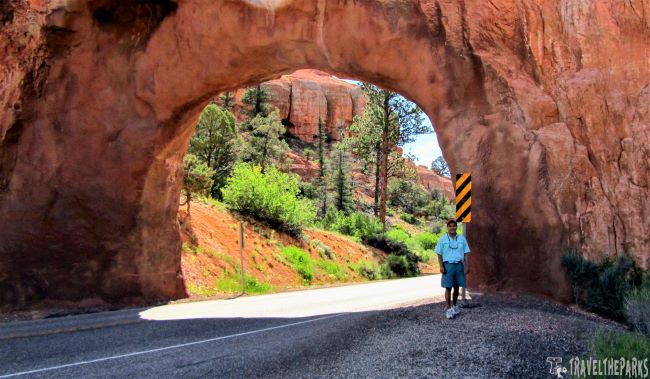
What Things Can I Do in Red Rock Canyon?
- Red Canyon Tunnel Trail– easy, 0.8 miles out and back trail. A set of switchbacks leads to decent views of the tunnels. Excellent location for pictures. Benches are along the trail if you need a rest. You could easily spend a day just hiking at Red Canyon.
- ATV Trails – there are multiple trails for ATVs in the park. Rentals are available in Tropic or Hatch.
- Mountain Bike Ride – start at the Red Canyon visitor center to Inspiration Point on a wide, paved path.
- Horseback Riding-take a ride to Thunder Mountain at Ruby’s Inn in Tropic. Travel the trails of the infamous Butch Cassidy.
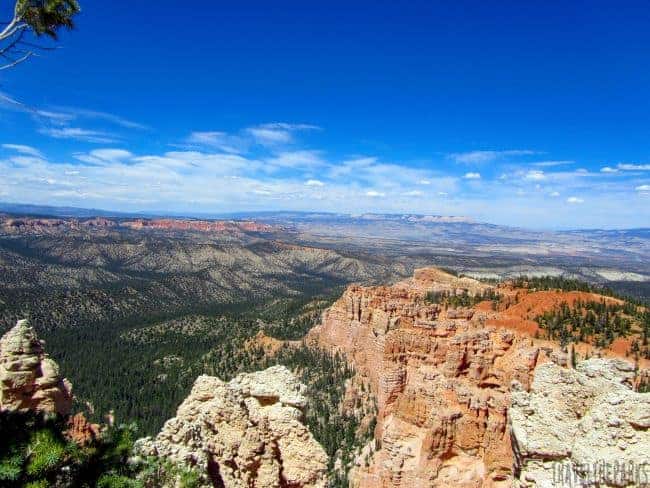
Bryce Canyon National Park: A Journey into the Otherworldly Beauty of Hoodoos
Located off UT-12, Bryce Canyon National Park is a quick 13 miles from Red Canyon. The park covers an area of over 35,000 acres. Many visit this park for its funky geological formations known as hoodoos. Bryce is unforgettable among the Utah 5. Over millions of years, erosion and weathering shaped the tall, thin spires of rock into the famous hoodoos. The park offers a range of hiking trails that provide access to the walk among the hoodoos and other geological features, such as arches and natural bridges. The most popular trail is the Rim Trail, which offers panoramic views of the park’s amphitheater and hoodoos.
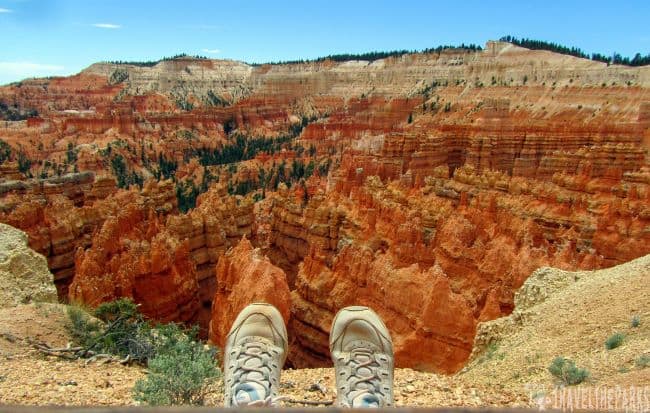
Where to Stay in Bryce Canyon During Your Southwest Trip
Ideally, it is nice to stay in the park. We stayed at the Bryce Canyon Lodge, close to amenities and the amphitheater hiking trails. Bryce Canyon has two campgrounds. At the entrance to the park, there are many lodges, secluded Stone Canyon Inn and Canyon Country Lodge in Escalante, to mention a few.
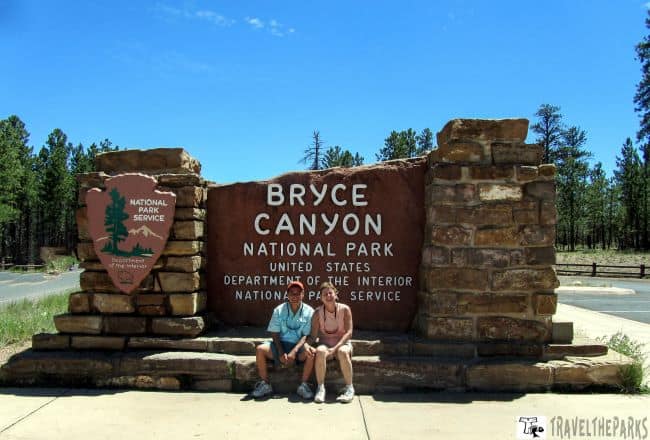
PRO Tip: Hikers should also be prepared for changing weather conditions and bring plenty of water, snacks, and appropriate clothing and footwear. A quality trekking stick would be advisable on any of the trails. We encourage visitors to follow Leave No Trace principles and respect the environment and wildlife.
What things can I add to my itinerary in Bryce National Park?
The Navajo Loop Trail is a must-do hike in Bryce Canyon National Park, popular with visitors of all ages and skill levels. This moderate to strenuous 1.3-mile trail features steep inclines and switchbacks that lead hikers through a captivating landscape of reddish-orange rock walls, particularly along the iconic “Wall Street” section. To have a varied experience, you can combine the Navajo Loop Trail with the slightly longer Queen’s Garden Trail, which provides a different perspective on the park’s iconic hoodoos. If timed right, hikers can end the hike with the breathtaking sight of the sunset.
- The visitor center is within a pinyon, juniper, and ponderosa forest plateau. Look through the exhibits and interactive displays for additional information on the park’s habitats.
- Horseback Riding – if you don’t want to hike, consider doing a trail ride on horseback. They venture down into the amphitheater to see the hoodoos up-close.
- Drive the scenic parkway, stopping at the many overlooks. Vast, rugged views of the amphitheater, each with a fresh offers a different perspective.
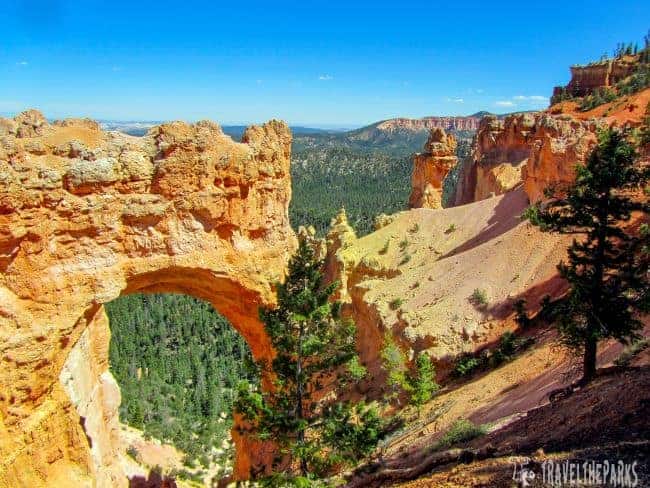
Southwest Grand Circle Road Trip Itinerary-Day 3
- Drive from Bryce Canyon to Grand Staircase-Escalante National Monument (approximately 1.5 hours)
- Spend the day exploring the park, hiking the trails, and checking out the unique geological formations.
- Stay overnight in or near Cannonville, Utah.
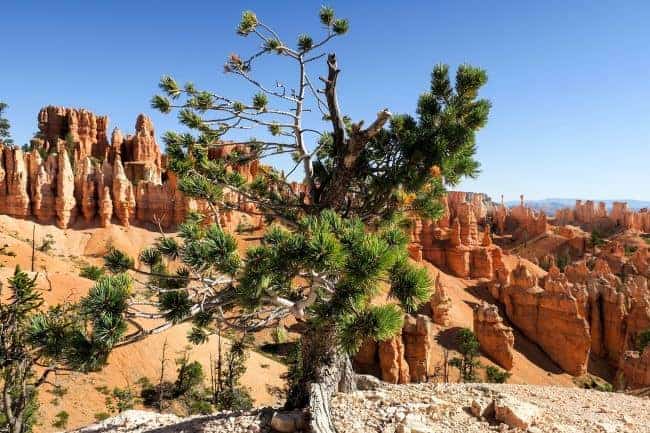
From Bryce Canyon to Escalante: Enchanting Landscapes and Ancient Treasures
Ut-12 east towards Capitol Reef, stop in Cannonville at the Escalante National Monument Visitor Center. Escalante is 20-minutes from Bryce. Take a break and check out the Escalante Interagency Visitor Center. If you are traveling by RV, the parking lot has a water fill-up station. If you need a permit to hike Coyote Canyon, you can pick one up here.
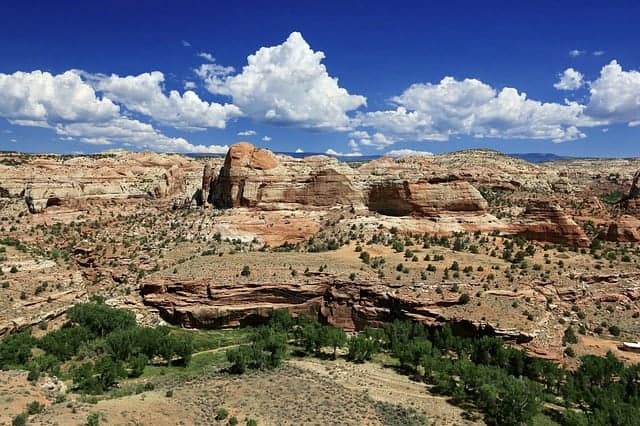
Grand Staircase-Escalante National Monument: Deciphering the Secrets of Time in the Southwest
The Bureau of Land Management (BLM) manages the monument, which covers over 1.9 million acres.
They named the Grand Staircase-Escalante National Monument for its unique geological formations, which resemble a giant staircase leading from the Grand Canyon in Arizona to Bryce Canyon National Park in Utah. The monument is also home to a diverse range of ecosystems, including high deserts, riparian zones, and deep canyons.
Visitors to the monument can explore a variety of outdoor recreational activities, including hiking, camping, rock climbing, and wildlife viewing. The monument is home to a variety of plant and animal species, including bighorn sheep, pronghorn antelope, and a variety of birds and reptiles.

Some of the most popular destinations within the Grand Staircase-Escalante National Monument include the Escalante River, the Hole in the Rock Road, and the Grand Staircase region. The monument’s boundaries have yielded many paleontological discoveries, making it a world-class fossil resource.
PRO Tip: Be sure to check road conditions at the visitor’s center before embarking on a hike. There are many great opportunities to explore this region.

The Trail to Lower Calf Creek Trail — an Oasis in the Desert
Because of time constraints, we could not fully explore the park as we had hoped. The Lower Calf Creek Trail is a prominent hike. The trailhead is located just off the All-American Road Scenic Byway, Utah State Route 12. It is a 6-mile out and back sandy trail that follows Calf Creek. The trail winds through a beautiful desert landscape with towering sandstone cliffs and colorful rock formations. Along the way, hikers can see a variety of desert flora and fauna, including juniper trees, cacti, and bighorn sheep. Look for the petroglyph art on the walls at stop #9 on the trail map. The waterfall is gorgeous! However, the water is freezing. Nonetheless, it was quite refreshing on a warm day.
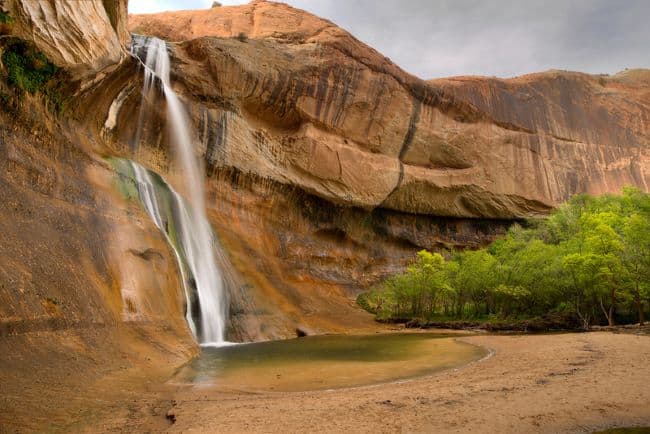
It’s important to note that many of these accommodations fill up quickly during peak travel season, so it’s a good idea to book in advance to secure your spot. Additionally, some of these options may have limited availability during the winter months, so be sure to check ahead if you’re planning to travel during this time.
Top Places to Stay Near Grand Staircase-Escalante National Monument
Cannonville is a small town near Grand Staircase-Escalante National Monument in Utah. While there aren’t many accommodation options directly in Cannonville, there are several places to stay nearby. Here are a few options:
- Grand Staircase Inn: This newly renovated hotel is in Cannonville and offers comfortable rooms with modern amenities, as well as a complimentary breakfast. It’s a great option for travelers looking for a convenient and affordable place to stay.
- Bryce Pioneer Village: This rustic motel is in Tropic, about 10 miles from Cannonville. It offers comfortable rooms and cabins, as well as a restaurant serving up tasty meals. It’s a great option for travelers looking to explore both Bryce Canyon National Park and Grand Staircase-Escalante National Monument.
- Stone Canyon Inn: This beautiful inn is in Tropic, about 12 miles from Cannonville. It offers luxurious accommodations in a stunning natural setting, with views of the surrounding red rock formations. It’s a great option for travelers looking for a more upscale and secluded experience.
- Escalante Cabins & RV Park: This collection of cabins and RV sites is located in Escalante, about 20 miles from Cannonville. It offers comfortable and affordable accommodations, as well as a convenient location for exploring Grand Staircase-Escalante National Monument.

What Must-See Attractions Are in Grand Staircase-Escalante National Monument?
- Devil’s Garden: (not to be confused with Arches NP) is an easy 1-mile loop trail to see Metate Arch. Good for all skill levels.
- Hike a Slot Canyon: You can combine Hike a Slot Canyon-Peek-a-boo and Spooky Gulch to create a 3.5-mile loop trail.
- If you are really adventurous, try canyoneering. Guides are available in Boulder/Escalante.
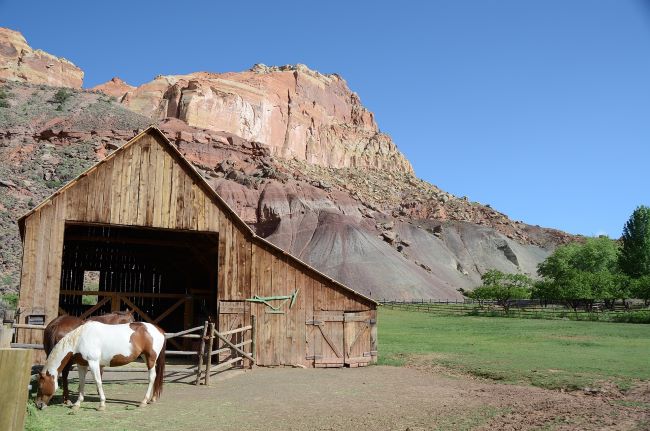
Southwest Grand Circle Road Trip Itinerary-Day 4
- Drive from Bryce Canyon National Park to Capitol Reef National Park (approximately 2.5 hours)
- Spend the day exploring the park, hiking the trails, and checking out the historic orchards and other landmarks.
- Stay overnight in or near the park.
The Mesmerizing Drive from Grand Staircase-Escalante to Capitol Reef National Park
By car, the most direct route is to take Utah State Route 12 east from Escalante towards Torrey. This drive takes approximately 1.5 to 2 hours and offers scenic views of the surrounding landscape, including the red rock canyons of the Escalante River and the towering peaks of the Boulder Mountain range. To reach Capitol Reef National Park, continue on UT-12 E to Torrey. The All-American Highway (U-12) ends at the junction of UT-24 in Torrey. In Torrey, turn right onto UT-24 E. Capitol Reef National Park is 9-miles from Torrey.
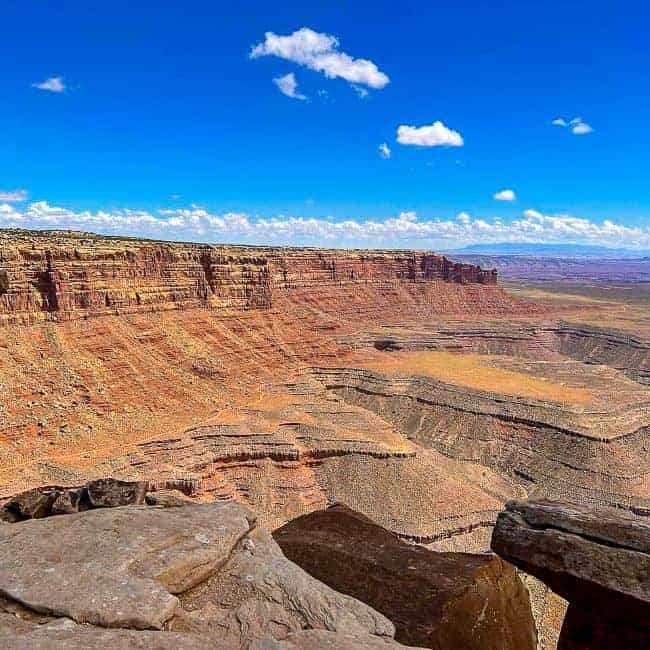
Uncovering the Ancient Beauty of Capitol Reef National Park
With good time on the road, we made a quick stop at the Gooseneck Overlook in Utah’s underappreciated national park, taking in its breathtaking vistas. It is definitely one to keep on your southwestern itinerary. Capitol Reef is renowned for its unique geological features, such as the Waterpocket Fold, the Hickman bridge, and Cassidy Arch. At the visitor center, the knowledgeable rangers equipped us with up-to-date trail information and printable maps to help us get started.
In addition to its stunning natural features, Capitol Reef also has a rich cultural history, with evidence of human habitation dating back thousands of years. Visitors to the park can explore historic homesteads, orchards, and other remnants of ancient settlements in the area.
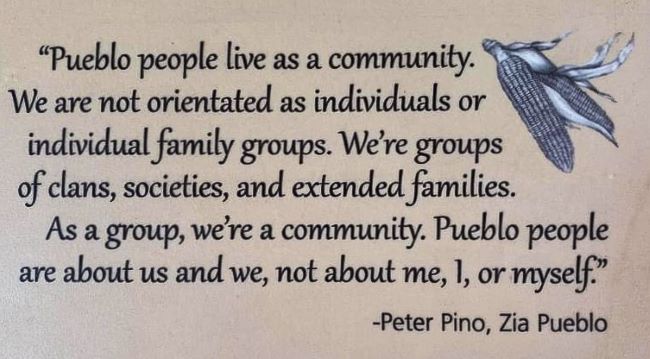
Gateway to Capitol Reef: Top Accommodations and Places to Stay Near the National Park
We highly recommend booking accommodations near Capitol Reef National Park in advance, especially during the busy summer travel season when lodging can fill up quickly. Of the options we considered, we preferred the Red River Ranch in Torrey for its convenient proximity to the park, even though it cost a bit more. The outstanding restaurant on-site was a bonus that made the extra expense worthwhile for us.
Other accommodations to choose from include:
- Capitol Reef Resort: This resort is located just outside the park entrance and offers a variety of accommodations, including cabins, teepees, and RV sites.
- Broken Spur Inn & Steakhouse: This hotel is in Torrey, Utah, just a few miles from the park entrance. It offers a variety of room types, as well as an on-site steakhouse and indoor pool.
- Red Sands Hotel: This hotel is also in nearby Torrey and offers comfortable rooms and suites, as well as a swimming pool and hot tub.
- Rim Rock Inn: This hotel is further along in nearby Fruita, Utah, within the park boundaries. It offers cozy rooms and cabins, as well as an on-site restaurant.
- Wonderland RV Park & Campground: This campground is in Torrey and has room for both tents and RVers, as well as cabins and yurts for rent.
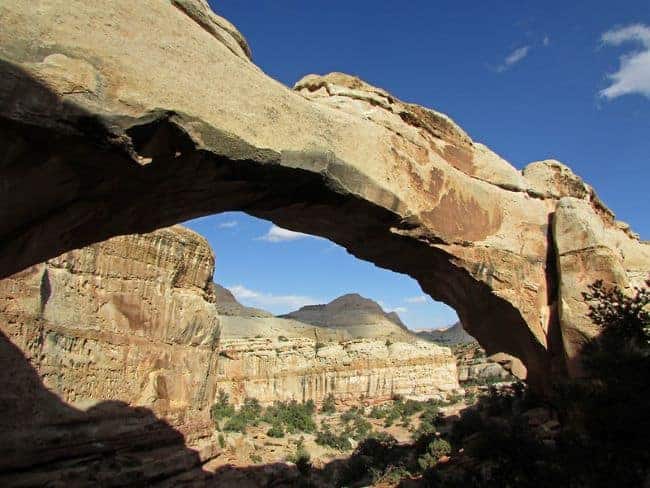
Crafting Your Ultimate Southwest Itinerary: The Best Things to Do at Capitol Reef National Park
The hike out to Hickman Bridge is about 1.8 miles round trip. It is considered moderate in difficulty. The trailhead is just off Utah State Route 24. The trail winds through a scenic desert landscape with views of the surrounding cliffs and canyons. Along the way, we passed through a narrow canyon towards some steep switchbacks. Climbing these before we reached the bridge itself.
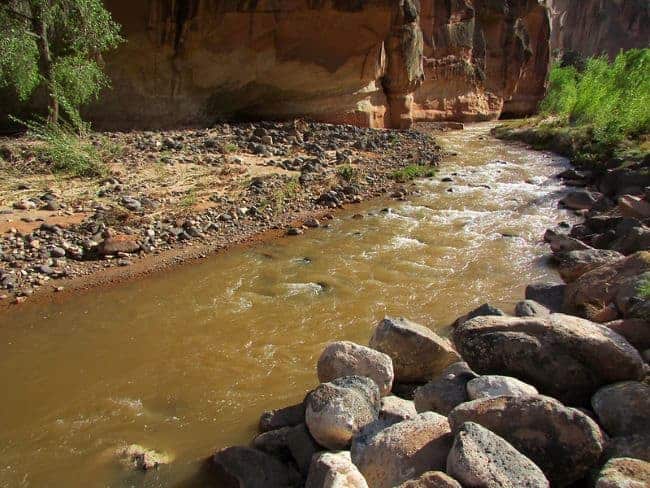
- Explore Historic Fruita – The district is home to a collection of well-preserved historic buildings, including a schoolhouse, a blacksmith shop, a general store, and several orchards. This desert oasis with an amazing story to tell. In season, enjoy fruit or pie from the orchard.
- Petroglyphs – accessible via a short boardwalk, we saw petroglyphs and other ancient rock art left behind by the Fremont culture, who inhabited the area over a thousand years ago.
- Chimney Rock Loop Trail – located off Utah State Route 24, it is a moderate 3.3-mile loop to a massive sandstone monolith. Along the way, we saw a variety of desert flora and fauna, including juniper trees, cacti, and lizards.
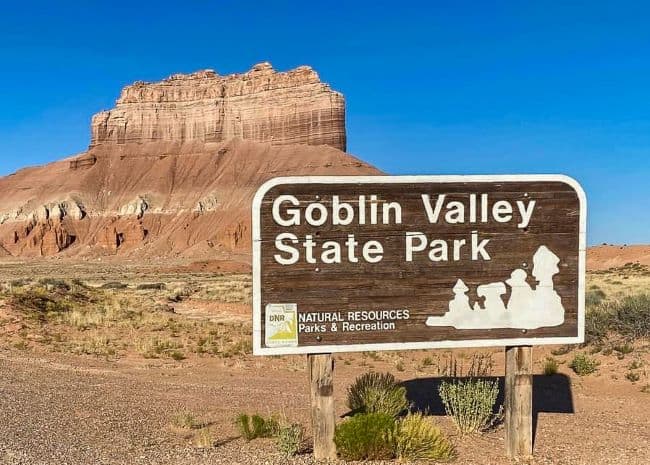
Southwest Grand Circle Road Trip Itinerary-Day 5
- Drive from Capitol Reef to Moab (2.5 hours)
- Stop at Goblin Valley State Park for a short hike (1-2 miles)
- Check in to hotel/campsite in Moab.
- Explore Arches National Park
- Hike to Delicate Arch (3 miles round trip)
- Visit other landmarks such as Balanced Rock, Landscape Arch, and Park Avenue
- Return to Moab for the night.

A Scenic Drive from Capitol Reef to Moab: See Utah’s Breathtaking Landscapes!
- The most direct route is to take Utah State Route 24 west from Capitol Reef towards Hanksville. From Hanksville, take Utah State Route 95 north towards Interstate 70. Take I-70 east until you reach US Route 191, which will take you south into Moab. This route takes approximately 2.5 to 3 hours, depending on traffic and road conditions.
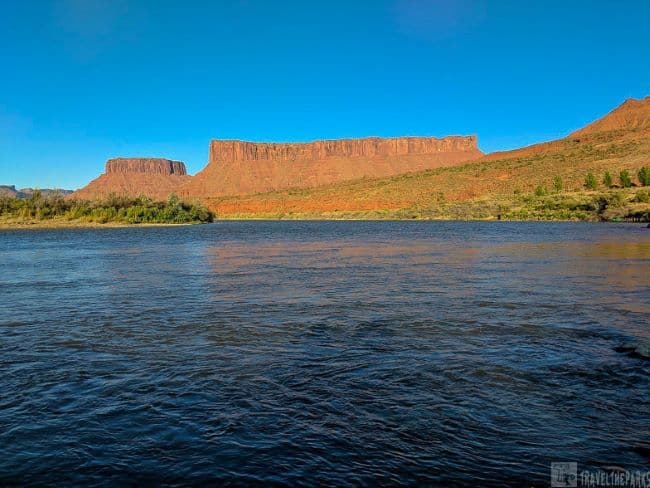
Finding Your Perfect Adventure Stay: A Moab Accommodation Guide
There are a variety of lodging options in Moab, including hotels, motels, campgrounds, and vacation rentals. Visitors can also find a range of dining options, from casual cafes to upscale restaurants, serving a variety of cuisines. We always stay at Red Cliffs Lodge, nestled beside the Colorado River, away from busy Moab. There are plenty of accommodation options in Moab, ranging from budget-friendly motels to high-end resorts. Here are a few suggestions based on different budgets and preferences:
- Budget-Friendly: If you’re looking for a budget-friendly option, Moab offers many affordable motels and inns, such as Motel 6 Moab, Big Horn Lodge, and Bowen Motel. These accommodations are clean, comfortable, and conveniently close to downtown Moab.
- Mid-Range: Moab also has many mid-range hotels and resorts, such as Best Western Plus Canyonlands Inn, Moab Springs Ranch, and Springhill Suites Moab. These hotels offer more amenities, such as swimming pools, fitness centers, and free breakfast.
- Luxury: If you’re looking for a luxurious experience, Moab offers several high-end resorts, such as Sorrel River Ranch Resort and Spa, Sunflower Hill Luxury Inn, and Aarchway Inn. These resorts offer breathtaking views, fine dining, and spa services.
- Camping: For those who prefer camping, Moab offers several campgrounds, such as Arches National Park Campground, Canyonlands National Park Campground, Under Canvas® Moab and Moab Valley RV Resort & Campground. These campgrounds offer a range of options, from basic tent camping to RV sites with hookups.
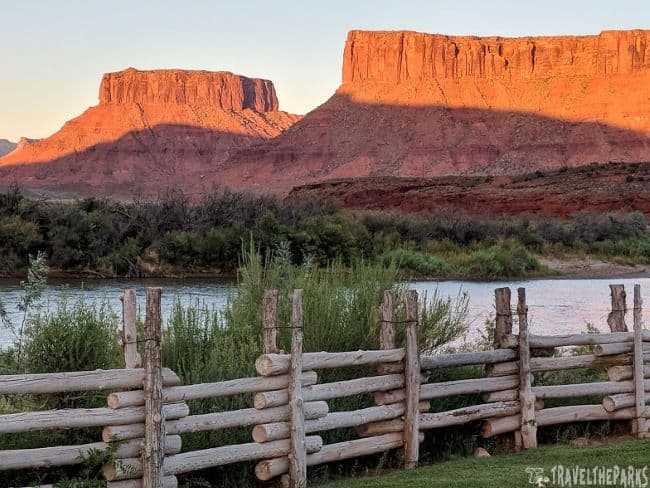
Embrace Adventure in Moab: An Outdoor Mecca
Moab is also home to a variety of other outdoor attractions, including the Colorado River, which offers opportunities for rafting and kayaking, and the Moab Rim, a popular destination for rock climbing.
The 34-mile round-trip scenic drive features magical views of the mesas, fins, and the Colorado River canyon. The overlook suspended 1100 feet above the canyon delivers outstanding views of the Colorado River. Even if you have limited time, I recommend doing this drive through the Islands in the Sky area.
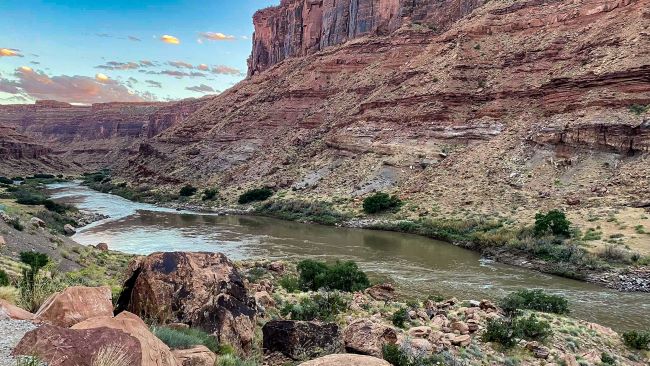
Southwestern Grand Circle Adventure in Moab Desert
Moab, Utah, is a popular destination for outdoor enthusiasts because of its beautiful natural surroundings and numerous outdoor activities. Here are some of the top things you can do in Moab:
- Hiking: Moab offers many hiking trails, ranging from easy walks to challenging backcountry hikes. Popular hikes include the Delicate Arch Trail in Arches National Park, the Corona Arch Trail, and the Hidden Valley Trail.
- Biking: Moab is also a popular destination for mountain biking. The area offers several trails for all skill levels, including the Slickrock Bike Trail, the Whole Enchilada Trail, and the Moab Brand Trails.
- Rafting: The Colorado River runs through Moab, and rafting on this river is a popular activity. You can take a half-day or full-day rafting trip through scenic canyons and rapids.
- Jeep tours: Moab offers guided jeep tours through the backcountry, which is a great way to explore the rugged terrain and see natural wonders such as arches and canyons.
- Rock climbing: Moab has many rock climbing areas, including Indian Creek, Wall Street, and Fisher Towers. You can hire a guide to take you to these areas and provide instruction.
- Sightseeing: Moab is home to two national parks: Arches National Park and Canyonlands National Park. You can spend several days exploring these parks, taking in the stunning natural beauty.
- Scenic drives: Moab offers several scenic drives, including the La Sal Mountain Loop Road, the Potash-Lower Colorado River Scenic Byway, and the Dead Horse Point State Park Scenic Drive.
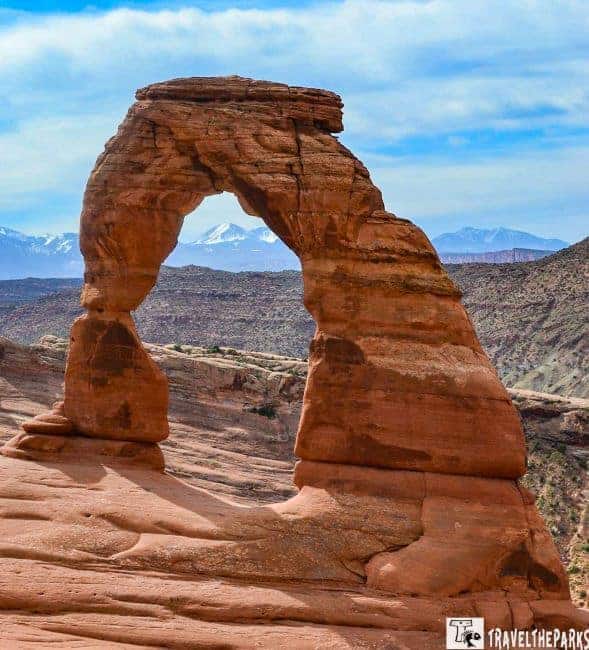
Arches National Park: A Journey into the Geological Story of Stone
It’s known for its stunning natural rock formations, including over 2,000 arches, towering spires, balanced rocks, and other geological wonders. The park covers an area of 76,679 acres and attracts over 1.6 million visitors every year.
We ended up doing a whirlwind tour of Arches, taking less than one day. Entering the park early in the morning is the best option for completing the scenic drive. The highlight of any visit to Arches National Park is the 3-mile Delicate Arch Trail. I must say that our fast-paced itinerary left me wanting more. This Utah 5 park will be on our list for a return trip with more time dedicated to hiking the trails.
PRO Tip: Timed entry tickets are required in addition to your park pass or entrance fee. You may enter the park before 7 am or after 4 pm without a timed entry ticket. The park will release tickets first-come, first-served on Recreation.gov three (3) months in advance in monthly blocks.

Arches National Park Grand Circle Must-Dos: Embracing the Magic of the Southwest
Here are some of the top things to see and do in Arches National Park:
- Delicate Arch: The most famous and iconic arch in the park, Delicate Arch, is a must-see attraction. You can view the arch from a distance or hike to it for a closer look.
- Park Avenue: This scenic drive is a beautiful way to see some of the most stunning rock formations in the park, including Courthouse Towers and the Three Gossips.
- Balanced Rock: This massive rock formation balances precariously on a narrow base and is a favorite photo spot for visitors.
- Fiery Furnace: This labyrinth of narrow canyons and towering fins is a popular spot for adventurous hikers. Have an extra day? Consider a guided tour. Make a reservation at recreation.gov.
- Windows Section: This area features several arches and rock formations, including the famous Double Arch.
- Landscape Arch: This long and narrow arch is one of the longest in the world and a popular hiking destination.
- Devil’s Garden: This area features several trails that lead to stunning rock formations, including Landscape Arch and the massive fins of the Dark Angel.
- Stargazing: Arches National Park is a great place for stargazing, with clear skies and minimal light pollution.
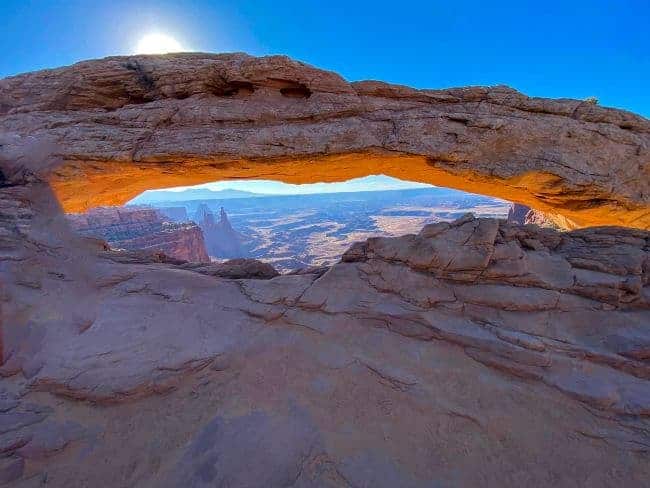
Southwest Grand Circle Road Trip Itinerary-Day 6
- Visit Canyonlands National Park, which is very close to Arches National Park
- Spend the day exploring the park, hiking the trails, and checking out the stunning vistas and canyons.
- Stay overnight another day in Moab near the park.
To drive from Moab to Canyonlands National Park, you have a few options depending on which entrance of the park you plan to visit. Here are the two main entrances and the driving routes to get there:
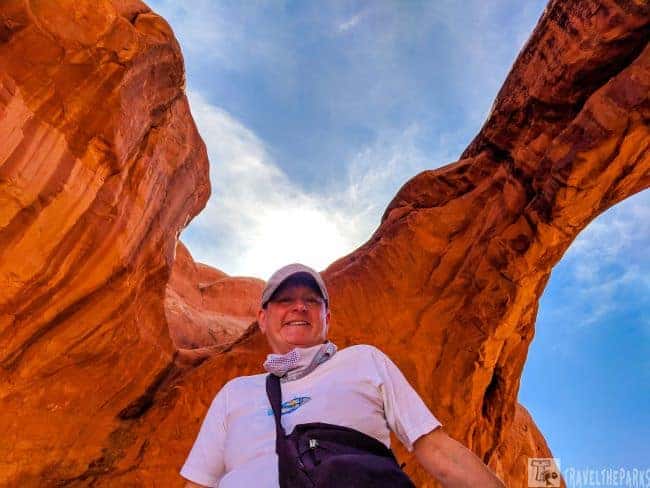
Short But Sweet: Driving Moab to Canyonlands National Park
- Needles District: From Moab, take US Route 191 south for about 40 miles until you reach Utah State Route 211. Turn left onto State Route 211 and follow the signs to Canyonlands National Park. The entrance to the Needles District is about 35 miles from US 191, and the drive takes approximately 1 hour, depending on traffic and road conditions.
- Island in the Sky District: From Moab, take US Route 191 south for about 10 miles until you reach Utah State Route 313. Turn left onto State Route 313 and follow the signs to Canyonlands National Park. The entrance to the Island in the Sky District is about 22 miles from Moab, and the drive takes approximately 40-50 minutes, depending on traffic and road conditions.
It’s important to note that the park entrances may have different hours and fees, so it’s recommended to check the National Park Service website or contact the park directly for the most up-to-date information. Also, be aware that some roads in the park may be unpaved or have high clearance requirements, so check the park map and road conditions before driving.
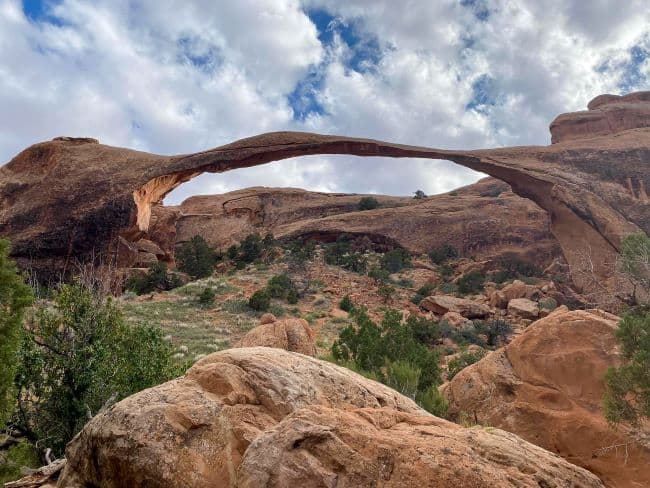
Canyonlands National Park: Discover the Vast Beauty and Timeless Grandeur of Utah’s Canyons
Compared to the other Utah 5, this park is enormous!! This park is divided into three districts: Island in the Sky, The Needles, and The Maze. A 40-minute drive from Moab is the Island in the Sky. It is in the northern portion of Canyonlands National Park. We made the hike to Mesa Arch early in the morning. It is easily one of the most photographed; particularly at sunrise when the sun lights up the arch while also giving an expansive view of the canyon below. It is almost like looking through a window. Worth getting up early and making the trek.

Canyonlands National Park: A Kaleidoscope of Grand Circle Adventures
Canyonlands National Park is a stunning area of natural beauty that offers a variety of activities and sights for visitors to enjoy. Here are some of the top things to do at Canyonlands:
- Scenic Drive: Canyonlands has several scenic drives that offer breathtaking views of the park’s unique landscape. The Island in the SkyDrive and the Needles Drive are two popular routes that take visitors to some of the most iconic viewpoints in the park.
- Hiking: Canyonlands has over 100 miles of hiking trails that vary in difficulty and length. Some of the most famous trails include the Mesa Arch Trail, the Grand View Point Trail, and the Syncline Loop Trail.
- Backpacking and Camping: Canyonlands has several backcountry campsites, and permits are required for overnight stays. The park also has several developed campgrounds for visitors who prefer car camping.
- Mountain Biking: The park has several trails that are open to mountain bikes, including the White Rim Trail, which is a 100-mile loop that offers stunning views of the park.
- River Rafting: The Colorado and Green Rivers run through Canyonlands, and visitors can experience the park from a different perspective by taking a guided river rafting trip.
These are just a few of the many things to do at Canyonlands National Park. No matter what your interests are, you’re sure to find something that you’ll love at this beautiful park.
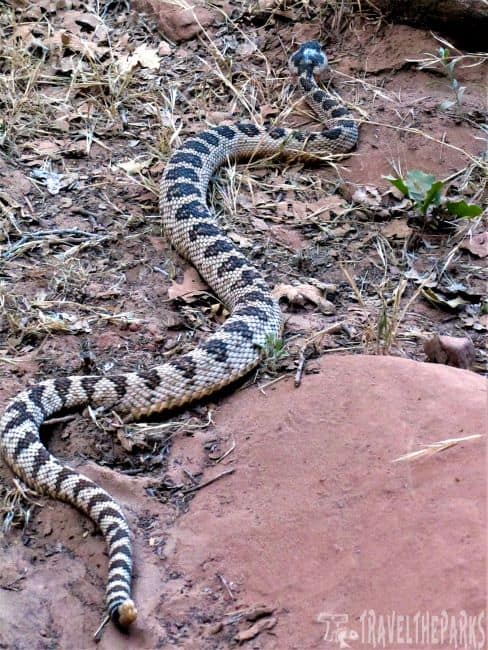
Southwest Grand Circle Road Trip Itinerary-Day 7
- Drive from Canyonlands National Park to Monument Valley (approximately 2.5 hours)
- Take a guided tour of the iconic rock formations and landscapes, and learn about the Navajo culture and history.
- Stay overnight in or near Monument Valley
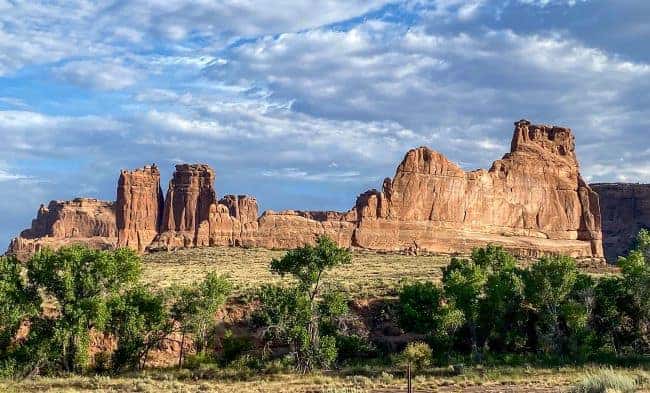
Continuing our Grand Circle Driving Canyonlands to Monument Valley
This drive takes about 2.5-3 hours without stops, but you’ll want to allow plenty of time to take in the scenery and visit the attractions along the way. When leaving Moab, be sure to stop at Wilson Arch. It is hard to miss, located beside Highway US-191. We scrambled up the arch to take a few pictures before moving on to Monument Valley.
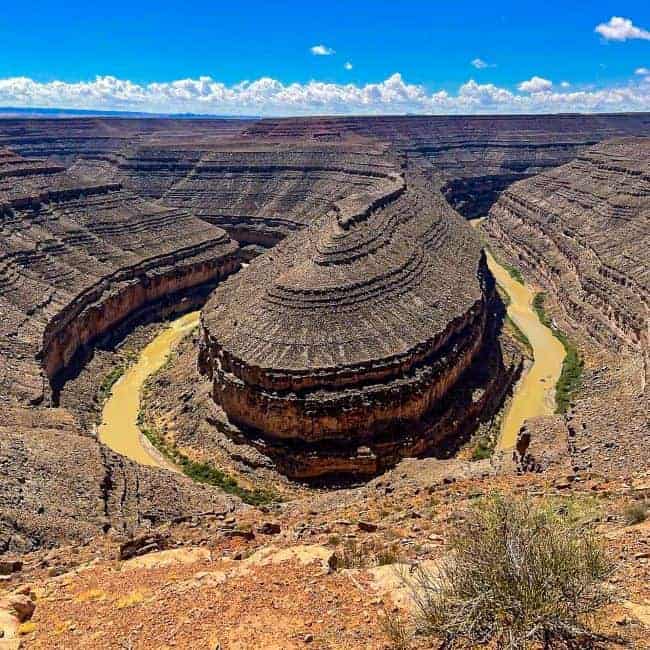
Natural Bridges: an Ideal Stop Along the Way
- Start in Moab, Utah, and take US-191 South for about 44 miles.
- Turn left onto UT-211 East and continue for approximately 40 miles until you reach Natural Bridges National Monument.
- Take the loop road through Natural Bridges National Monument to see the three natural bridges that are the park’s major attractions.
- After leaving Natural Bridges National Monument, continue on UT-261 South for about 34 miles until you reach Mexican Hat.
- Stop at the San Juan River overlook to see the spectacular view of the river as it winds through the canyons.
- From Mexican Hat, take US-163 South for approximately 25 miles until you reach Monument Valley.

Interesting Fact: The name “Dead Horse Point” has a grim origin. According to local lore, cowboys in the late 1800s herded wild mustangs onto the point’s narrow neck of land, using it as a natural corral. Tragically, some horses became stranded on the point and perished from thirst or exposure, leading to the area’s macabre moniker.
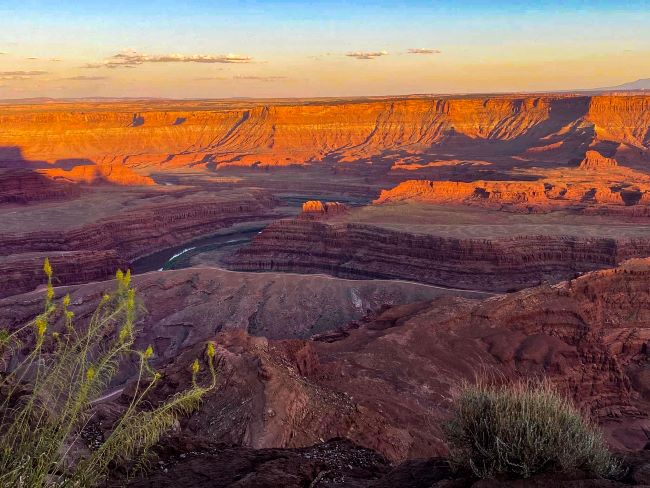
A Spiritual Journey into Monument Valley Tribal Park
I love the movie history linked to the Monument Valley Tribal Park. So they filmed many early Hollywood westerns, capturing the natural beauty of the valley. John Wayne and John Ford made these buttes and mesas famous. If you watch the first movie ever filmed here, “The Searchers,” the Mittens are visible in many of the scenes. However, this landscape has a spiritual connection as well. Vehicles on the self-guided loop are limited to the valley drive. However, a Navajo guide will take travelers further into the backcountry. If you make use of Navajo Spirit Tours, they will share the legends for each formation. At the Big Hogan, you get a surreal moment listening to your guide play a traditional song on the flute. This natural amphitheater had magical acoustics!
NOTE: Remember that Arizona does not observe daylight savings, but the Navajo Reservation does.

Where to Stay in Monument Valley
On our grand circle tour, we wanted to stay directly inside Monument Valley Tribal Park. I think it is worth the higher price to stay at the View Hotel. Sitting on your balcony as the sunrise illuminates the Mittens is the quintessential symbol of the American Southwest. I believe you get what you pay for when you stay here. Additionally, you can find choice accommodations at the hotel at Goulding’s Resort or the campground for RV campers. Trekkers will still have proximity to the park.
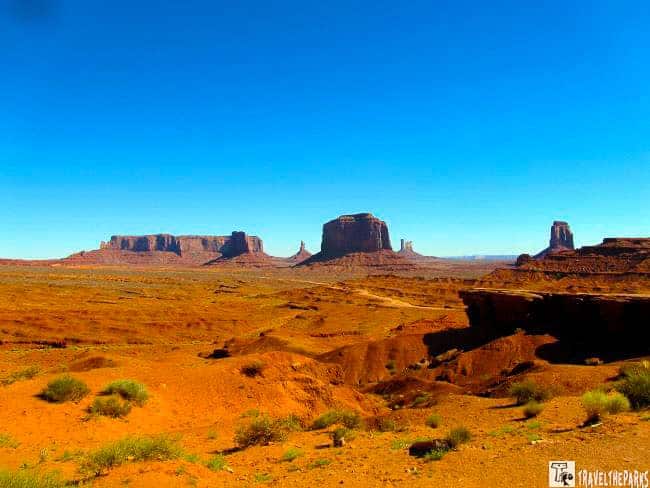
What Things Can I Do at Monument Valley?
We opted to use Navajo Spirit Tours for the scenic 17-mile loop to see the mesas, buttes and John Ford Point made famous by the movies.
- Once you arrive at Monument Valley, explore the park’s famous rock formations, which are often featured in countless movies and TV shows.
- Photograph the famous Mittens at sunset. The light illuminating them is perfect from your balcony at The View Hotel.
- Take a guided tour of the park to learn more about the Navajo culture and history.
- Watch the sunset over the park’s iconic buttes and spires.
- Overnight either in Monument Valley or Page, Arizona.
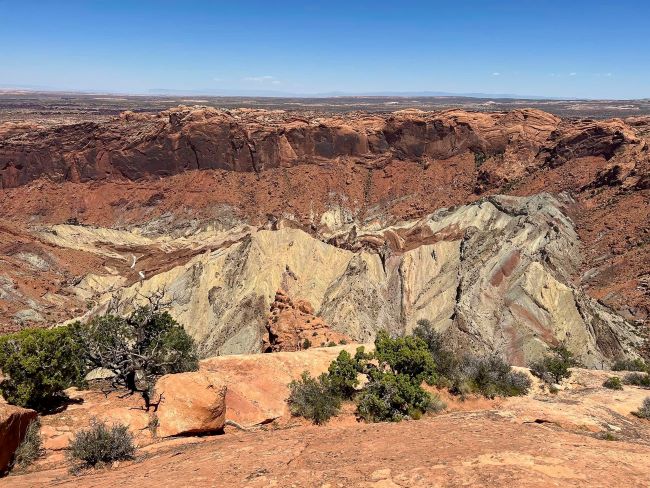
Southwest Grand Circle Road Trip Itinerary-Day 8
- Drive from Monument Valley to Page, Arizona (approximately 4 hours)
- Visit the Glen Canyon Dam and take a tour of the power plant.
- Explore the Antelope Canyon, which is known for its stunning rock formations and colors.
- Visit the Horseshoe Bend, a breathtaking natural formation of the Colorado River
- Explore Lake Powell, which offers many outdoor activities, including boating, fishing, and hiking.
- Stay overnight in or near Page.
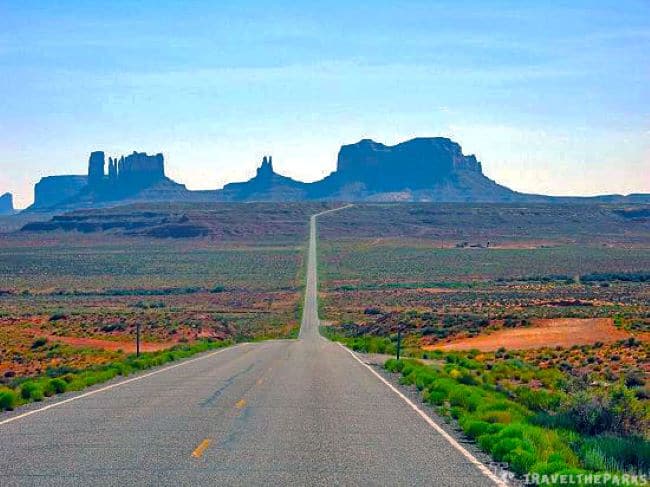
Driving from Monument Valley to Page, Arizona (Glen Canyon Recreation Area)
This drive takes approximately 2.5-3 hours without stops.
- Start in Monument Valley and head south on US-163 for about 25 miles. Photograph the highway from the famous Forrest Gump Point.
- Turn right onto US-160 West and continue for approximately 50 miles until you reach Kayenta.
- In Kayenta, you can visit the Navajo Code Talkers Exhibit, which honors the contributions of Navajo soldiers during World War II.
- From Kayenta, continue on US-160 West for another 20 miles until you reach the junction with US-89 North.
- Turn left onto US-89 North and continue for approximately 73 miles until you reach Page, Arizona.
- Along the way, you can stop at the Navajo National Monument, which features well-preserved cliff dwellings and ancient artifacts.
- Once you arrive in the town of Page, you can visit Lake Powell, which offers a variety of water sports and outdoor activities.
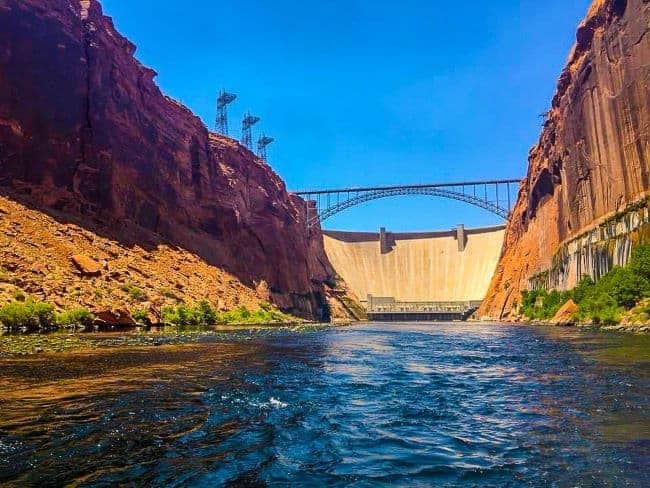
More Southwest Grand Circle Splendor: Exploring Page, Arizona, Horseshoe Bend, and Lake Powell
The city of Page is a jumping-off point for boating on Lake Powell, which is part of the Glen Canyon National Recreation Area. Lake Powell is a vast reservoir that provides a variety of recreational opportunities, including boating, fishing, swimming, and kayaking. On our visit, we hired a guide to get out on the lake and do some bass fishing. In the early morning, the shimmering heat of the day already reflects off the surface of the water. As we depart the marina, the lake is perfectly calm. The scenery is breathtaking. On our trip, we caught quite a few smallmouth bass and stripers. At the end of the day, our guide took us up Antelope Canyon. The rising walls that are above you are fascinating. If you love to fish, this lake produces quality bass.
Glen Canyon National Recreation Area is a must-visit destination for anyone who loves outdoor adventure and natural beauty. With so much to see and do, you could easily spend several days exploring the area.

Home Away from Home: Where to Stay in the Town of Page, Arizona
Page, Arizona, is a popular destination for visitors to Lake Powell, Antelope Canyon, and other nearby attractions. Here are some of the most popular places to stay in the town of Page:
- Lake Powell Resort: This resort is on the shores of Lake Powell and offers a variety of rooms and suites, some with lake views. It has a restaurant, an outdoor pool, and is near the Wahweap Marina.
- Courtyard by Marriott Page at Lake Powell: This hotel is in downtown Page and offers a variety of rooms and suites. It has a restaurant, an outdoor pool, and a fitness center.
- Best Western Plus at Lake Powell: This hotel is in downtown Page and offers a variety of rooms and suites. It has a restaurant, an outdoor pool, and a hot tub. We loved our stay here.
- Hyatt Place Page/Lake Powell: This hotel is in downtown Page and offers a variety of rooms and suites. It has a restaurant, an outdoor pool, and a fitness center.
- Hampton Inn & Suites Page – Lake Powell: This hotel is in downtown Page and offers a variety of rooms and suites. It has a restaurant, an outdoor pool, and a fitness center.
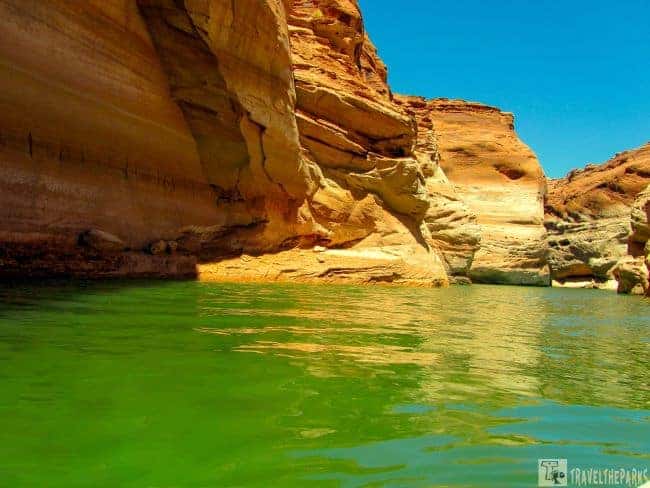
Discovering an Adventurer’s Paradise in the Glen Canyon Recreational Area
Glen Canyon National Recreation Area is a vast protected area in northern Arizona and southern Utah that spans over 1.2 million acres of land and water.Renowned for its breathtaking red rock canyons, mesas, and cliffs, this region also boasts the serene, azure waters of Lake Powell. Here are some highlights of the recreation area:
- Hiking – there are many hiking trails in the recreation area, ranging from easy walks to strenuous hikes that offer stunning views of the canyons and mesas.
- River rafting – The Colorado River runs through Glen Canyon and offers a variety of rafting trips, from short half-day excursions to multi-day adventures.
- Scenic drives – The scenic drives along Route 89 and Route 98 offer spectacular views of the red rock canyons and mesas.
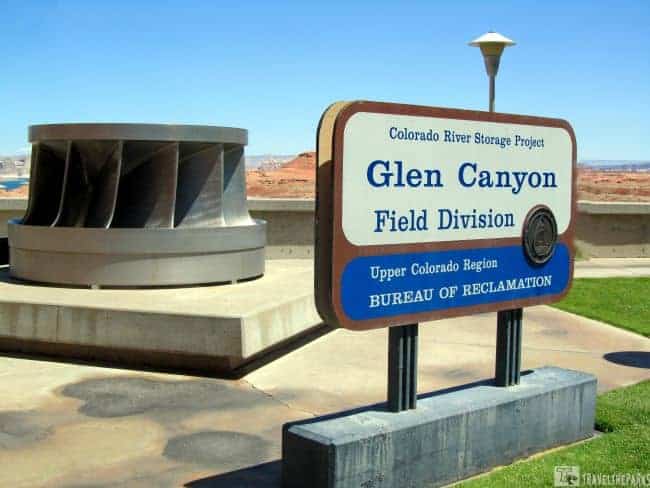
Exploring Glen Canyon National Recreational Area: the many Possibilities
- Famous Horseshoe Bend – a horseshoe-shaped bend in the Colorado River that offers stunning views of the canyon. Arriving for sunset or sunrise. The Colorado River carved this incredible landscape over eons.
- You can also take a guided tour of Antelope Canyon, a slot canyon known for its unique rock formations and stunning colors. A Navajo guide conducts these tours. The light on these slot canyon walls is a photographer’s dream.
- Visit the Glen Canyon Dam – The Glen Canyon Dam is a massive concrete structure that controls the flow of the Colorado River and creates Lake Powell. Take a tour of the Glen Canyon Dam for only a $10 fee. We had a great Navajo guide!
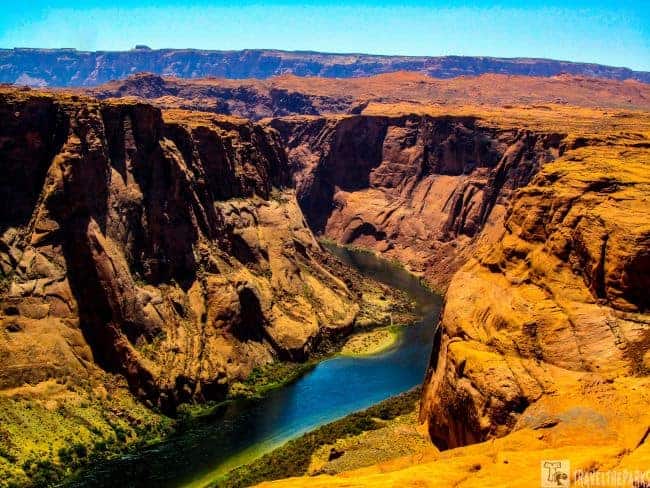
Iconic Horseshoe Bend: Picture Perfect
Horseshoe Bend is an “entrenched meander” located 5 miles downstream from the Glen Canyon Dam. They recently improved this 1.5-mile trail, building a new platform, the juts out over the canyon. We went before the improvements. You could sit on the edge of the canyon and look down at the river. Pretty scary. The city of Page now collects a $10 vehicle fee for parking. It is worth stopping just to take photographs of this iconic bend in the river.
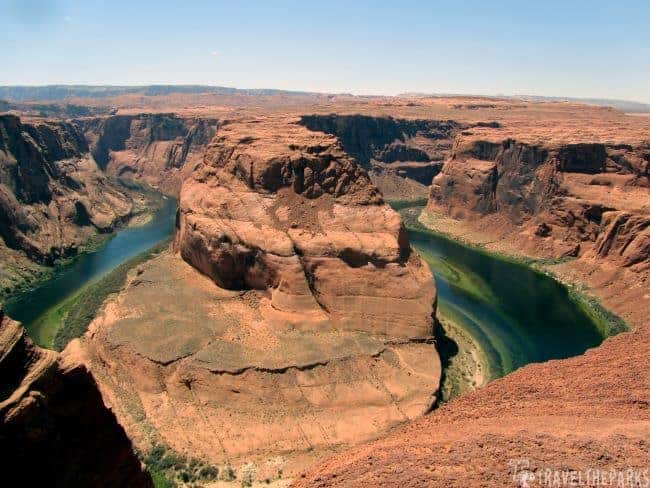
Southwest Grand Circle Road Trip Itinerary-Day 9
- Spend the day exploring the park, hiking the trails, and taking in the awe-inspiring views.
- Stay overnight in or near the Grand Canyon National Park.
Taking the Road Less Traveled: Driving to the South Rim of the Grand Canyon from Page, Arizona
- From Page, Arizona, to the Grand Canyon Village is a 2-3 hour journey if you don’t do any stops. However, there are plenty of viewpoints. Each is a unique perspective and worth getting out of the car to see.
- The most direct route is to take US-89 south to Flagstaff, and then take AZ-64 north to the South Rim.
No matter how you choose to travel from Page to the Grand Canyon South Rim, be sure to take your time and enjoy the stunning scenery along the way. There are many beautiful sights to see in northern Arizona, so consider making stops at places like Cameron Trading Post or Wupatki National Monument if you have time. We stopped at the Cameron Trading Post for a restroom break, perusing their extensive gift shop, and eating the best Navajo tacos ever!
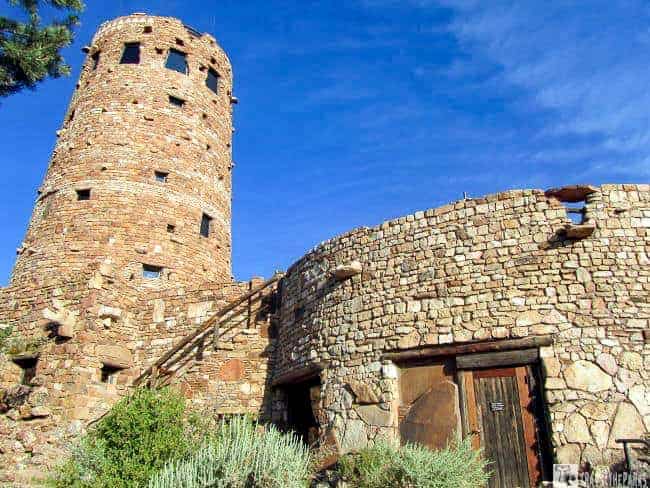
Not Your Ordinary Canyon: Visiting Grand Canyon National Park -South Rim
If you have a bucket list, this is one park that should be at the top; it will not disappoint. We could consider the Grand Canyon one of the seven wonders of the world. It is a great place to get incredible pictures as you hike through some beautifully colored rock formations. Numerous wildflowers bloom in the spring on many of the trails.
The Grand Canyon National Park’s South Rim is a breathtaking destination that offers stunning views and plenty of opportunities for outdoor activities. Take a drive along Desert View Drive or Hermit Road to enjoy some of the most spectacular views of the Grand Canyon. Coming from Page and stopping at the Desert Watchtower, you get your first glimpse of the canyon. I must say that nothing comes close to standing on the rim of the Grand Canyon. You get a true understanding of the canyon’s sheer size.

Grand Canyon South Rim Retreat: Where to Stay for a Memorable Experience
There are several lodging options available on the South Rim of the Grand Canyon. Here are some of the most popular places to stay:
- Bright Angel Lodge: This historic lodge is on the rim of the canyon and offers a variety of rooms and cabins. It has a restaurant, gift shop, and is near the Bright Angel Trailhead. We rented a cabin here on our first trip. Loved the expansive canyon views early in the morning while listening for bugling elk.
- El Tovar Hotel: Built in 1905, this elegant hotel is on the rim of the canyon. It offers a variety of rooms and suites, a restaurant, and a lounge with stunning views of the canyon.
- Kachina Lodge: This lodge is on the rim of the canyon and offers a variety of rooms and suites. It has a restaurant, gift shop, and is near the Bright Angel Trailhead.
- Thunderbird Lodge: This lodge is on the rim of the canyon and offers a variety of rooms and suites. It has a restaurant, gift shop, and is near the Bright Angel Trailhead.
- Yavapai Lodge: This lodge is about a mile from the rim of the canyon and offers a variety of rooms and cabins. It has a restaurant, a gift shop, and is near the Market Plaza.
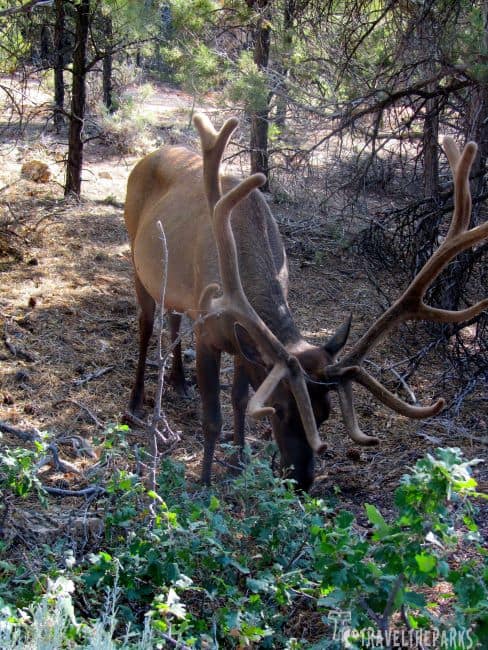
Exploring the Grand Canyon’s Abundance of Activities
- Hiking – The South Rim offers a variety of hiking trails for all skill levels, ranging from easy paved paths to challenging backcountry trails. Some popular trails include the Bright Angel Trail to Phantom Ranch, the South Kaibab Trail, and the Rim Trail.
- Mule Rides – Take a mule ride down into the Grand Canyon for a unique and unforgettable experience. Several guided tours are available, ranging from one hour to multi-day trips. If you opt for the mule ride, you definitely need to make your reservations far in advance.
- Ranger Programs – Attend a ranger-led program to learn more about the park’s history, geology, and wildlife.
- Grand Canyon Village – Explore the historic Grand Canyon Village, which offers a variety of restaurants, shops, and lodging options.
- Sunrise and Sunset Views – Witness the stunning colors of the Grand Canyon during sunrise or sunset. Be sure to arrive early and secure a good viewing spot.
- Museums and Visitor Centers – Visit the various museums and visitor centers throughout the park to learn more about the history and natural wonders of the Grand Canyon.
PRO Tip: Hiking in the canyon, remember to bring plenty of water, wear comfortable shoes, and follow all park regulations and safety guidelines.
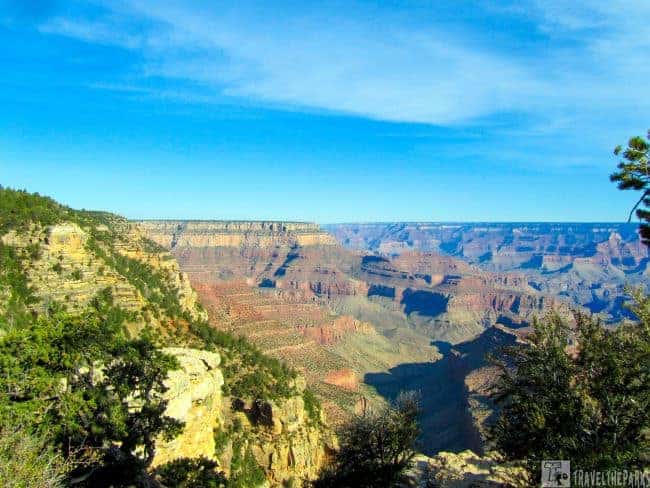
Southwest Grand Circle Road Trip Itinerary-Day 10
- In the morning before leaving the canyon, spend a leisurely morning walking the canyon rim or to the train station depot to see the elk and mule deer.
- Take a memorable train ride to Williams, AZ, on the Grand Canyon Railroad.
- Stop at the Grand Canyon Visitor Center to learn about the history, culture, and geology of the canyon.
- Hike the phenomenal Havasu Falls-this is still on my bucket list.

Driving from Grand Canyon National Park to Las Vegas, Nevada: Returning to the City of Lights
The most direct route is to take AZ-64 east to US-89 and then head south to Flagstaff. From Flagstaff, take I-40 west to Kingman, and then head north on US-93 to Las Vegas. The drive takes about 4.5 hours, depending on traffic and stops. To add Hoover Dam to your itinerary, take exit 48. Take the ramp right for US-93 toward Las Vegas.
- There are many interesting sights to see, such as the Hoover Dam, Route 66, and the historic town of Kingman.
- Arrive in Las Vegas in the evening
We spent our last night in Las Vegas on our return trip. Staying at the Best Western McCarran Inn, nearest to McCarran airport and the car return. You can cruise the Las Vegas Strip or take in a show.

An Engineering Marvel: Make the Detour to Experience Hoover Dam
As you near the end of your grand circle tour, why not plan a quick stop at the Hoover Dam? The Hoover Dam is about 120 miles from the Grand Canyon’s South Rim. Hoover Dam is a good place to take a walk over the Pat Tillman Memorial Bridge for a few pictures or take a tour of the visitor’s center and inside of the dam.
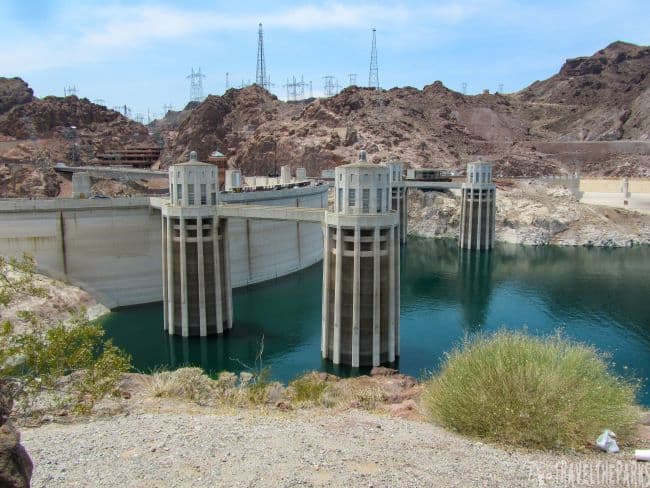
Power, Beauty, and Engineering at Hoover Dam
These are just a few of the many things to do at the Hoover Dam. Whether you’re interested in history, architecture, or outdoor adventure, the Hoover Dam is a must-see destination in the Southwest.
- Hoover Dam Tour – Take a tour of the Hoover Dam, which offers a close-up look at the dam’s history, construction, and operation. There are several tour options available, including a power plant tour and a dam tour, which takes you inside the dam and gives you a chance to see the massive turbines and generators.
- Walk the Mike O’Callaghan-Pat Tillman Memorial Bridge – Take a walk on the Hoover Dam Bridge, which spans the Colorado River and offers stunning views of the dam and the surrounding landscape.
- Lake Mead Recreation Area – Visit the Lake Mead Recreation Area, which is located just downstream from the Hoover Dam. The area offers many outdoor activities, including boating, fishing, hiking, and camping.
- Visitor Center – Check out the Hoover Dam Visitor Center, which features exhibits and displays on the history and construction of the dam. The center also offers tours and educational programs.
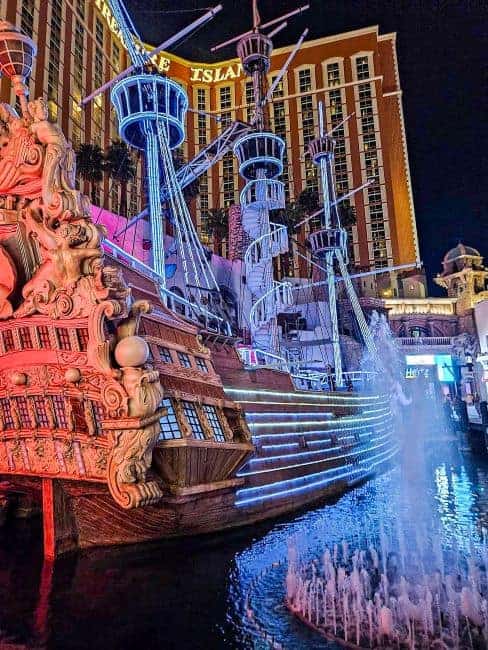
Grand Circle Adventure: Essential Resources for Planning Your Epic Journey
- If you plan to visit multiple parks, one way to support our national parks is to purchase an annual park pass. The America the Beautiful pass gains you entrance into all the national parks and federal recreational lands. The pass costs $80 for one year.
- Reservations for excursions and lodging need to be made well before your trip. I usually book 6-months ahead for accommodations.
- Download all your apps before reaching the parks. No cell service or Wi-Fi is available in most areas. Bring paper maps with you. I always laminate our maps before our trips. They last forever!
- If a park shuttle is available in the park, try to use it. This will save you from circling parking areas looking for open space.
- The landscapes you’ll encounter in the Southwest are truly awe-inspiring. Don’t forget to bring a good camera, and capture the moments that resonate with you, so you can relive the experience later and share it with others.
- Bring LOTS of water. Most places will not have water, and if they do, it will be more expensive to buy. I know what it is like to hike without it. It can be a serious issue if you get dehydrated.
- You will need a daypack to carry your binoculars and sunscreen.
- Do not attempt to feed or pet the animals. Always maintain a safe viewing distance.

Final Thoughts on Planning Your Ultimate Guide to a Grand Circle Road Trip Itinerary
Planning a Southwest Grand Circle road trip itinerary can be an incredibly rewarding experience. This iconic 1,400-mile route links breathtaking locations such as the Grand Canyon, Zion, Bryce Canyon, Arches, and Monument Valley. Whether you have a week or two, the Grand Circle road trip offers an awe-inspiring route through red rock landscapes, ancient history, and star-filled desert skies.
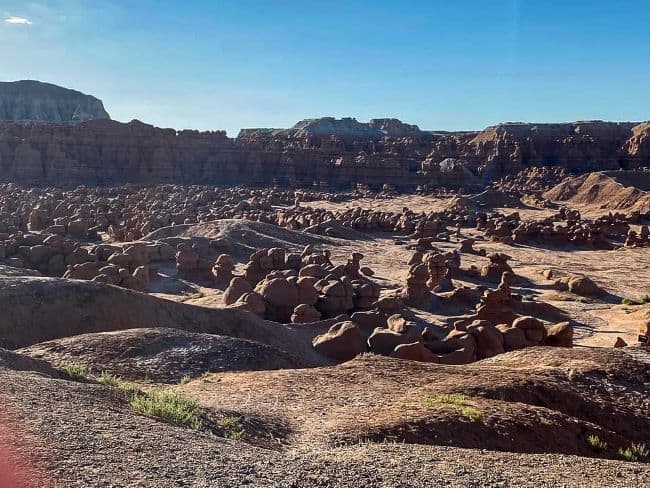
For us, exploring the Southwest Grand Circle Road Trip Itinerary—through Utah’s Mighty 5 and northern Arizona—was the adventure of a lifetime. I hope this itinerary helps guide and inspire your own unforgettable journey. With a bit of planning, a spirit of adventure, and an open mind, you’ll be ready to make the most of this breathtaking region. Safe travels, and enjoy every moment of your Southwest Grand Circle Road Trip!
Have you visited any of the Utah 5 parks? What about the Arizona side? Please share your experience in the comments below.


